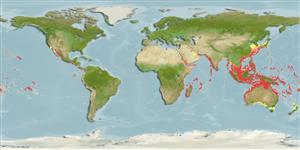Common names from other countries
Classification / Names / Names
ماع يماسا | فدارتم | Catalog of Fishes (gen., sp.) | ITIS | CoL | WoRMS
Environment: milieu / climate zone / depth range / distribution range
يسانش موب
گنس بآ هب هتسباو; قمع تارييغت 0 - 133 m (Ref. 100991). Tropical
Indo-Pacific: East and South Africa to eastern Polynesia.
Length at first maturity / Size / Weight / نس
Maturity: Lm ? range ? - ? cm Max length : 9.5 cm SHL يسنج صاوخ نودب / رن سنج; (Ref. 349); common length : 4.0 cm SHL يسنج صاوخ نودب / رن سنج; (Ref. 349)
Length based on occurrence record; to be replaced with better reference. Usually found under slabs and small corals (also Ref. 799), frequently occurring in groups (Ref. 349). Also found in shallow subtidal waters (Refs. 349, 2925). Dead shells found on the beaches (Ref. 88739). Members of the family Cypraeidae are primarily carnivores (Ref. 67623).
Life cycle and mating behavior
غولب | لثم دیلوت | یزیر مخت | اه مخت | Fecundity | )ورال ( دازوت
Members of the order Neotaenioglossa are mostly gonochoric and broadcast spawners. Life cycle: Embryos develop into planktonic trocophore larvae and later into juvenile veligers before becoming fully grown adults.
یلصا ذخآم
عجارم | هدننك گنهامه | ناراكمه
Poutiers, J.M. 1998. (Ref. 349)
NCUI زمرق تسرهف رد تيعضو (Ref. 130435)
ستياس رظن زا تيعضو (Ref. 108899)
Not Evaluated
Not Evaluated
اه ناسنا یارب رطخ
Harmless
یناسنا هدافتسا
تاليش – يريگ يهام: يراجت
| FishSource |
اهرازبا
رتشيب تاعالطا
Age/Sizeدشرنزو - لوطلوط - لوطيسانش تخير)ورال ( دازوتيناوارف
يتنرتنيا عبانم
Estimates based on models
Preferred temperature
(Ref.
115969): 22.5 - 29.1, mean 28 (based on 2376 cells).
یريذپ بيسآ
Low vulnerability (10 of 100).
تميق هقبط
Unknown.
